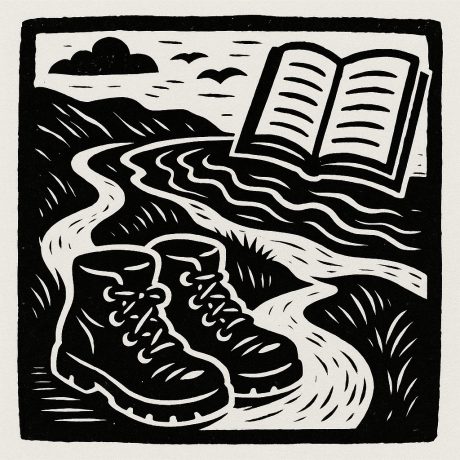
Raynor Winn’s The Salt Path (Penguin, 2018) captured public attention with its raw, lyrical account of homelessness, illness, and walking the South West Coast Path. But the book is more than just a memoir: it’s also a powerful lens through which to examine how contemporary publishing operates. Winn’s story, and its success, raises vital questions about truth, mediation, healing narratives, and the role of publishers.
Drawing on my recent reflections—including a post responding to Winn’s reaction to The Observer, and a broader examination of memoir ethics—here are six key lessons for writers, educators, and students of publishing.
1. Truth in Memoir Is Always Mediated and Negotiated
Winn’s memoir opens with a standard-seeming disclaimer: names and details have been changed, medical content is based on personal experience, not professional advice. But this short paragraph hints at the deep narrative and ethical negotiations that underpin the memoir form. As I argue in my ethical reflections on memoir, life-writing often relies on selective memory, reconstructed dialogue, and strategic omissions—not out of deceit, but to protect others, to clarify a story arc, or to render emotional truth from the chaos of lived experience.
In my post on truth, I ask: How much truth is enough? Memoirists must constantly navigate the blurry terrain between authenticity and privacy, between the urge to reveal and the responsibility to withhold.
This thirst for the confessional isn’t new. In fact, it surged in the 1990s, when my former PhD supervisor, Blake Morrison, published And When Did You Last See Your Father?, a memoir that became a bestseller by laying bare the contradictions of his relationship with his father, a charismatic, difficult, often neglectful country doctor. Morrison’s portrait was unflinching — described as ‘fearless’ by Granta his publisher. His father, a proud man humbled by illness and death, became a symbol of a generation of men who were rarely examined with such tenderness and critique. The book was widely praised, but also criticised for being too personal, too revealing, underscoring how memoir continues to test the boundaries of what should or shouldn’t be said. The book, with its enormous commercial success (it too was made into a popular film) also paved the way for many more memoirs like it: unearthing family secrets, dealing with aspects of shame, exploring the devastating effects of illness. All topics which hitherto had not been so publicly aired in literary memoirs.
Winn’s The Salt Path, like Morrison’s memoir, stands in this confessional tradition, but also modernises it, offering readers not just a portrait of a person, but a pathway out of despair, mediated through nature, walking, and the symbolic redemptions of narrative form.
2. Disclaimers Reflect Publishing’s Need to Balance Risk and Meaning

The disclaimer in The Salt Path is a legal shield, but it also hints at deeper tensions. In my blog on the history of publishing, I show how publishing has long walked a tightrope between what is ethical and what is commercial. A memoir may feel confessional and raw, but behind the scenes, publishers must anticipate liability, ethical backlash, and questions of accuracy.
This becomes especially urgent in a publishing world where readers crave “real” stories but where authors often face trauma, defamation concerns, or the need to fictionalise for legal or emotional safety.
3. Agents and Editors Are the Quiet Architects of Memoir
It’s tempting to view The Salt Path as a solitary cry from the heart, a lone voice walking out into the wilderness, but no memoir reaches readers in that form. Behind every published book is a team of professionals shaping, nurturing, and often reshaping the narrative. Agents play a pivotal role in identifying work that not only tells a compelling story but speaks to a cultural moment; editors work closely with authors to refine the arc, tone, structure, and clarity of that story. These quiet acts of narrative architecture often go unacknowledged, but they are essential to the success of a book like Winn’s.
While I do not focus on editors directly in my piece on publishing as pedagogy, I explore how publishing should be understood as a collaborative, iterative process: a mode of co-creation that extends beyond writing alone. On the MA in Creative Writing and Education, we consider editing not as interference, but as a form of mindful listening and response: a dialogue between writer and reader, mentor and mentee, creator and culture. The Salt Path may feel raw and intimate, but it was also carefully scaffolded, framed to speak to readers in ways that resonate, inspire, and ultimately sell.
4. Marketing Teams Don’t Just Sell Stories—They Shape Them
Penguin’s marketing team did more than promote The Salt Path—they branded it as a soul-soothing, healing journey through nature. This aligned with a collective longing, especially post-2010, for meaning beyond the screen. In my piece on creative writing and marketing, I examine how marketing decisions (cover design, blurb tone, publicity focus) frame how a book is read.
Winn’s narrative resonated with cultural anxieties: desk-bound exhaustion, ecological crisis, economic precarity. But it’s no accident that these themes were made visible. They were positioned—through blurbs, interviews, and media framing—as therapeutic. In a sense, marketing didn’t just sell the book; it helped write it.
5. Memoirs Like This Tap into Shared Emotional and Cultural Longings
In my blog on publishing and emotional needs, I explore how the act of publishing, not just the end product, can support writers’ emotional wellbeing by providing validation, connection, and a sense of authorship over their own lives. The Salt Path resonates so strongly not just because of Winn’s story, but because of how it meets a collective yearning: to find healing through nature, simplicity, and movement, at a time when many feel confined by screens, financial pressures, and systemic disconnection.
Yet this emotional pull deserves scrutiny. Does the memoir suggest that walking alone can heal deep structural wounds like homelessness, chronic illness, or grief? Or does it invite us into a comforting narrative arc that many cannot access? On the Creative Writing and Education MA, we interrogate these tensions—examining not only how publishing supports emotional needs, but also how it shapes cultural fantasies about redemption, resilience, and recovery.
6. Publishing Must Be Understood as a Creative, Critical, and Ethical Practice
If you’re teaching creative writing—or studying it—you need to know more than how to write. You need to understand how publishing works: the systems, power structures, and possibilities it offers. In my blog on using publishing to create thriving creative writing communities, I argue for publishing as a pedagogical tool. It fosters voice, develops confidence, and allows writers to engage with real audiences.
The story of The Salt Path shows that publishing is more than production. It is interpretation. It is meaning-making. It is politics. And it is, always, an invitation to reimagine what it means to tell the truth.
Want to explore these themes more? Join us on the MA in Creative Writing and Education, where we don’t just write: we publish, reflect, and transform.

Further Reading:
